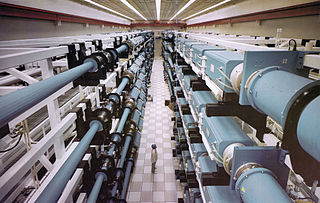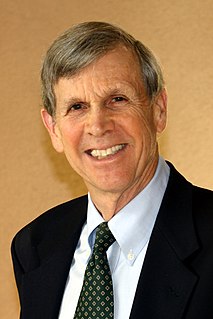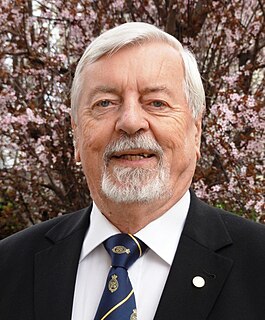
Lawrence Livermore National Laboratory (LLNL) is a federal research facility in Livermore, California, United States, founded by the University of California, Berkeley in 1952. Originally a branch of the Lawrence Berkeley National Laboratory, the Lawrence Livermore laboratory became autonomous in 1971 and was designated a national laboratory in 1981.

Inertial confinement fusion (ICF) is a fusion energy research program that initiates nuclear fusion reactions by compressing and heating targets filled with thermonuclear fuel. These are pellets typically containing a mixture of deuterium 2H and tritium 3H. In current experimental reactors, fuel pellets are about the size of a pinhead and contain around 10 milligrams of fuel. Bigger power reactors are envisaged for the future as affordable safe clean carbon-free energy sources of limitless scale burning the deuterium plentiful in the oceans.
This timeline of nuclear fusion is an incomplete chronological summary of significant events in the study and use of nuclear fusion.

The National Ignition Facility (NIF), is a large laser-based inertial confinement fusion (ICF) research device, located at the Lawrence Livermore National Laboratory in Livermore, California. NIF uses lasers to heat and compress a small amount of hydrogen fuel with the goal of inducing nuclear fusion reactions. NIF's mission is to achieve fusion ignition with high energy gain, and to support nuclear weapon maintenance and design by studying the behavior of matter under the conditions found within nuclear weapons. NIF is the largest and most energetic ICF device built to date, and the largest laser in the world.

Nova was a high-power laser built at the Lawrence Livermore National Laboratory (LLNL) in California, United States, in 1984 which conducted advanced inertial confinement fusion (ICF) experiments until its dismantling in 1999. Nova was the first ICF experiment built with the intention of reaching "ignition", a chain reaction of nuclear fusion that releases a large amount of energy. Although Nova failed in this goal, the data it generated clearly defined the problem as being mostly a result of Rayleigh–Taylor instability, leading to the design of the National Ignition Facility, Nova's successor. Nova also generated considerable amounts of data on high-density matter physics, regardless of the lack of ignition, which is useful both in fusion power and nuclear weapons research.

Curtis Bruce Tarter is an American theoretical physicist. He was the director of the Lawrence Livermore National Laboratory from 1994-2002. As director emeritus he recently published the first comprehensive history of the laboratory.

Argus was a two-beam high power infrared neodymium doped silica glass laser with a 20 cm (7.9 in) output aperture built at Lawrence Livermore National Laboratory in 1976 for the study of inertial confinement fusion. Argus advanced the study of laser-target interaction and paved the way for the construction of its successor, the 20 beam Shiva laser.
The Department of Applied Science at the University of California, Davis was a cooperative academic program involving the University of California, Davis and the Lawrence Livermore National Laboratory (LLNL). It was established in the fall of 1963 by Edward Teller, director of LLNL, and Roy Bainer, then dean of the UC Davis College of Engineering. The department was discontinued in 2011.

Edward Moses is an American physicist and is the former president of the Giant Magellan Telescope Organization. He is a past principal associate director for the National Ignition Facility & Photon Science Directorate, where he led the California-based NIF, the largest experimental science facility in the US and the world’s most energetic laser, that hopes to demonstrate the first feasible example of usable nuclear fusion.
George H. Miley is a professor emeritus of physics from the University of Illinois at Urbana–Champaign. Miley is a Guggenheim Fellow and Fellow of the American Nuclear Society, the American Physical Society and the Institute of Electrical and Electronics Engineers. He was Senior NATO Fellow from 1994 to 1995, received the Edward Teller Medal in 1995, the IEEE Nuclear and Plasma Science Award in Fusion Technology in 2003 and the Radiation Science and Technology Award in 2004. He holds several patents.

Heinrich Hora is a German-Australian theoretical physicist who made contributions to solid state physics, optical properties of plasma with relativistic and quantum effects and nonlinear dynamics with applications of lasers for producing nuclear fusion energy. He lives in Sydney where he is an emeritus professor at the University of New South Wales and a former vice-president of the Royal Society of New South Wales.
Fusion ignition is the point at which a nuclear fusion reaction becomes self-sustaining. This occurs when the energy being given off by the fusion reactions heats the fuel mass more rapidly than various loss mechanisms cool it. At this point, the external energy needed to heat the fuel to fusion temperatures is no longer needed. As the rate of fusion varies with temperature, the point of ignition for any given machine is typically expressed as a temperature.
Riccardo Betti is the Robert L. McCrory professor of Mechanical Engineering and Physics and Astronomy at the University of Rochester, in Rochester, NY. Since 2004, he has also acted as the Director of the Fusion Science Center at the Laboratory for Laser Energetics. He received is Ph.D. from the Department of Nuclear Engineering at the Massachusetts Institute of Technology in 1992. Prior to that he studied at the University of Rome (Italy), where he graduated with honors with a degree in Nuclear Engineering in 1987.

LIFE, short for Laser Inertial Fusion Energy, was a fusion energy effort run at Lawrence Livermore National Laboratory between 2008 and 2013. LIFE aimed to develop the technologies necessary to convert the laser-driven inertial confinement fusion concept being developed in the National Ignition Facility (NIF) into a practical commercial power plant, a concept known generally as inertial fusion energy (IFE). LIFE used the same basic concepts as NIF, but aimed to lower costs using mass-produced fuel elements, simplified maintenance, and diode lasers with higher electrical efficiency.
John Hopkin Nuckolls is an American physicist who worked his entire career at the Lawrence Livermore National Laboratory. He is best known for the development of inertial confinement fusion, which is a major branch of fusion power research to this day. He was also the lab's director from 1988 until 1994, when he resigned to become an Associate Director at Large. He was awarded the Ernest Orlando Lawrence Award in 1969, the James Clerk Maxwell Prize for Plasma Physics in 1981 and the Edward Teller Award in 1991.
Dmitri Dmitriyevich Ryutov is a Russian theoretical plasma physicist.
John D. Lindl is an American physicist who specializes in inertial confinement fusion (ICF). He is currently the Chief Scientist of the National Ignition Facility at the Lawrence Livermore National Laboratory.
Jürgen Meyer-ter-Vehn is a German theoretical physicist who specializes in laser-plasma interactions at the Max Planck Institute for Quantum Optics. He published under the name Meyer until 1973.
The history of nuclear fusion began early in the 20th century as an inquiry into how stars powered themselves and expanded to incorporate a broad inquiry into the nature of matter and energy, as potential applications expanded to include warfare, energy production and rocket propulsion.








